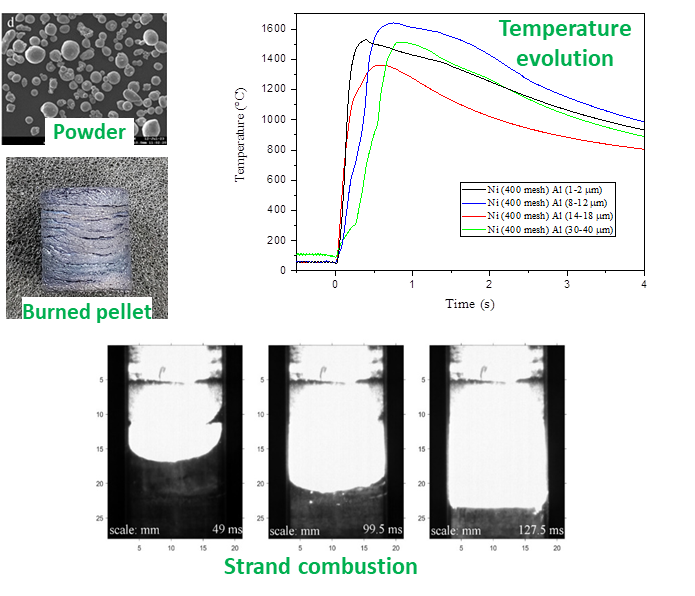OVERVIEW
Our research activities fall in the domain of thermal and fluid sciences and they involve application of concepts of heat transfer, fluid mechanics, thermodynamics, and other related subjects. Specifically, we work on the development and characterization of next-generation energetic materials. These are of relevance to rocket, space, and underwater propulsion , development of advanced explosives, hydrogen generation, and other energy-conversion applications. We work on problems of practical importance, but the focus is placed on fundamental sciences. Our work focusses on the following aspects:
(1) combustion
(2) propulsion
(3) nano-scale transport processes and properties
(4) multi-phase and turbulent flows
SYSTEMS
Our focus has been on metal-based energetic materials, as they have very high energy densities. We also work on other energetic materials (such as CHNO based) that are relevant to propulsion and explosion applications. We endeavor to charaterize the following systems and formulations:
(1) Metal particles or powders burning in gasesous oxidizers
(2) Novel "green" propellants consisting of metal fuel and liquid oxidizers
(3) Gelled liquid mono- and bipropellants
(4) Nanoscale thermite and intermetallic systems
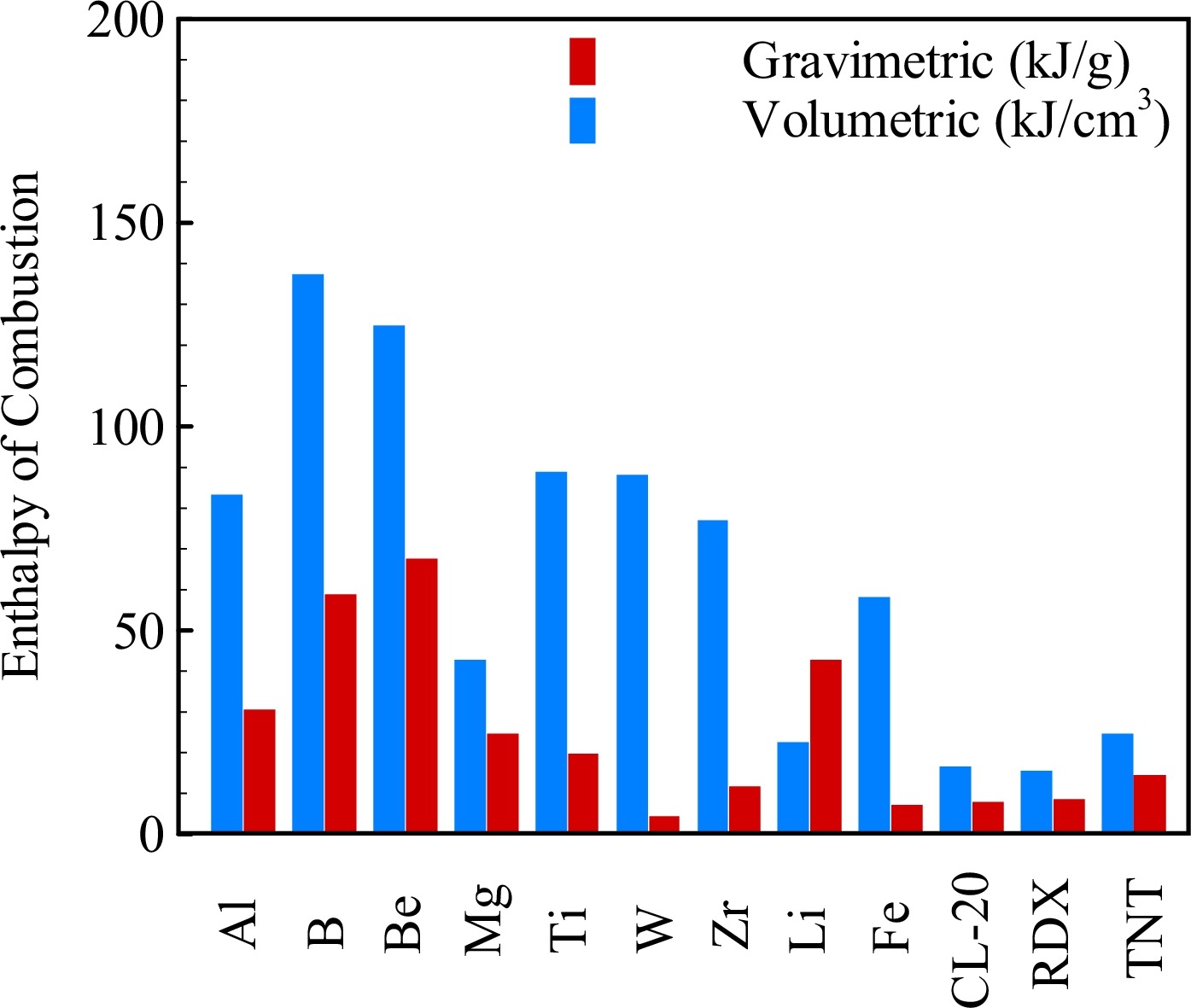
Figure: Comparison of energy densities of metals and conventional energetic materials (Sundaram et al. PECS 2017; Reference )
METHODS
We do high-fidelity multiscale modelling and simulations that span a wide range of scales, from atomistic to meso- and macro scales. All theoretical studies are done in companion with experimental studies or in the context of experimental data to ensure that the developed model is valid and captures the essential physics of the problem. The atomistic-scale simulations enable us to obtain insights on the underlying physicochemical processes and predict fundamental thermodynamic and transport properties at nano-scales. The meso/macro simulations are essentially Computational Fluid Dynamics (CFD) simulations and are used to understand combustion behavior and propulsive performance of novel energetic materials. In addition, experimental studies are conducted which complement the computational studies conducted in the lab.
SELECTED RECENT PROJECTS AT IITGN
Molecular Simulations of Nano-Scale Heat Transfer in Rarefied/Non-Continuum Regime
The goal of the project is to understand the mechanism of heat transfer at nano-scales, where the continuum approximation breaks down. At such scales, the matter needs to be modeled as a discrete collection of atoms and molecules rather than as a continuum. As a result, molecular scale simulations have been conducted to quantify the heat transfer rates at nano-scales and to discover the underlying mechanisms.
Relevant Publications
Pinki et al., JPC C 2020
Thoudam et al., JPC C 2020
Thoudam et al., Int. J. Therm. Sci. 2022
Kulkarni et al., IJHMT 2020
Mane et al., Surface Science 2018
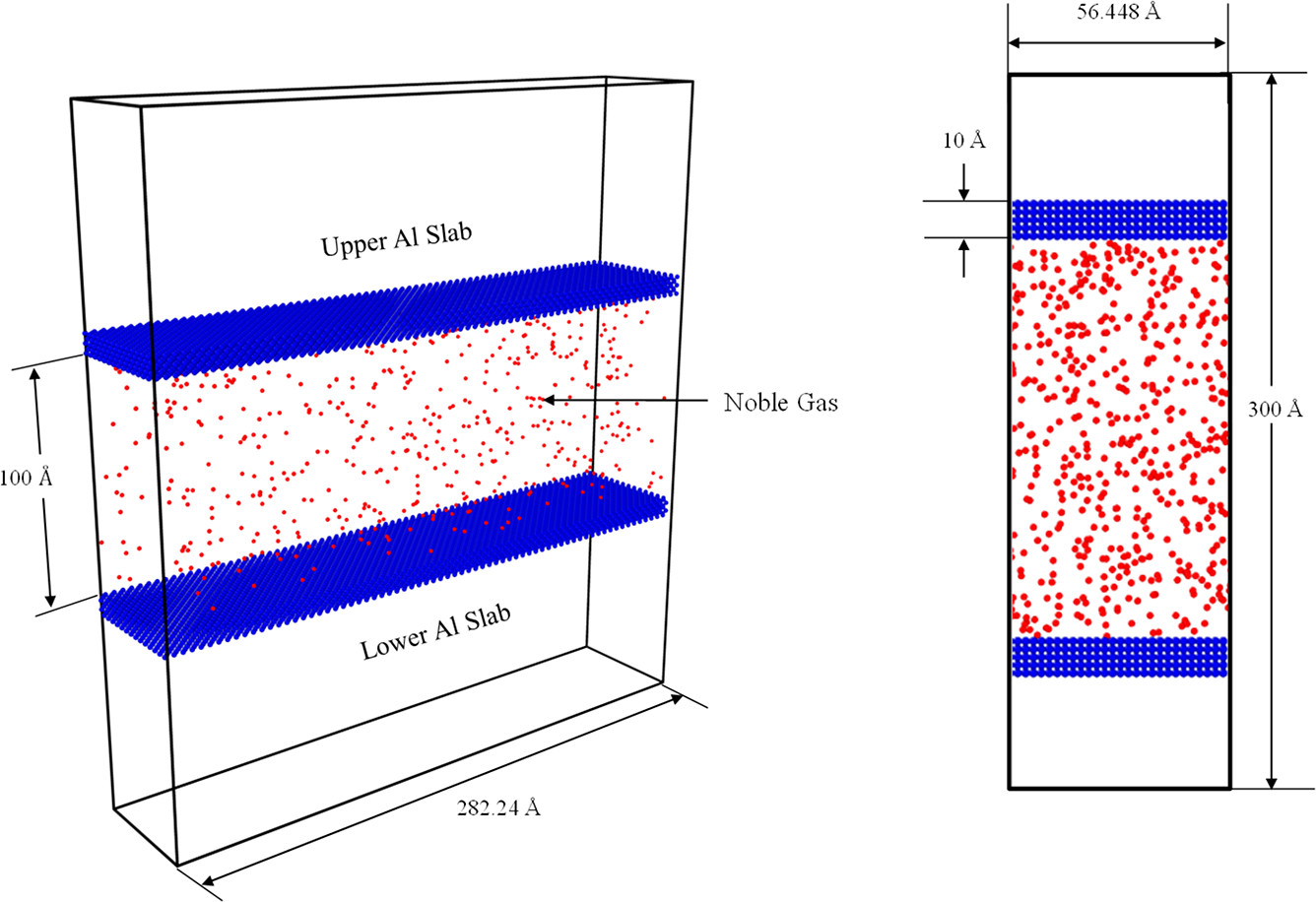
CFD Simulations of MultiPhase Reacting Flows in Rocket Motors
The goal of the project is to simulate the multiphase reacting flows in rocket motors. An attempt is being made to quantify performance metrices such as thrust, specific impulse, characteristic veloity, as well as to capture the evolution of flow and temperature fields. The project will also attempt to resolve some of the issues that plague some of the novel propellants and strive to optimize the overall design of rocket motor.
Multiscale Modeling and Simulations of Combustion of Pellets of Reactive Core-Shell Particles
A comprehensive theoretical and computational framework is developed to simulate combustion and flame propagation in a packed pellet of core-shell structured intermetallic energetic particles. A coupled multiscale approach is adopted, in which the atomic diffusion process in micron-scale particles is strongly linked to the macro-scale energy transport in the pellet. Species transport equations are solved for the core-shell structured particle, with the diffusivity treated as a temperature-dependent parameter. The energy equation is solved for the pellet, with the source term governed by the evolution of species concentrations in the core-shell structured particle. A quasi-implicit numerical scheme is developed to ensure stability and a generalized Crank-Nicholson scheme is adopted to tune the degree of implicitness and control the order of temporal accuracy. Further, the temperature dependence of properties and phase change of materials are considered. The theoretical and computational framework is applied to simulate combustion of pellets with Ni/Al core-shell particles of diameters in the range of 10–100 µm. An attempt is made to simulate experiments as closely as possible and the predictions are compared with the available experimental data. Suitable diffusivity model parameters that best describes the experimental data are identified. Parametric studies are conducted to study the effects of particle size, interstitial gas, and pressure on the combustion velocity. Results provide novel insights on the combustion process and directions for future studies.
Relevant Publication
Garai and Sundaram, Combustion and Flame 2023
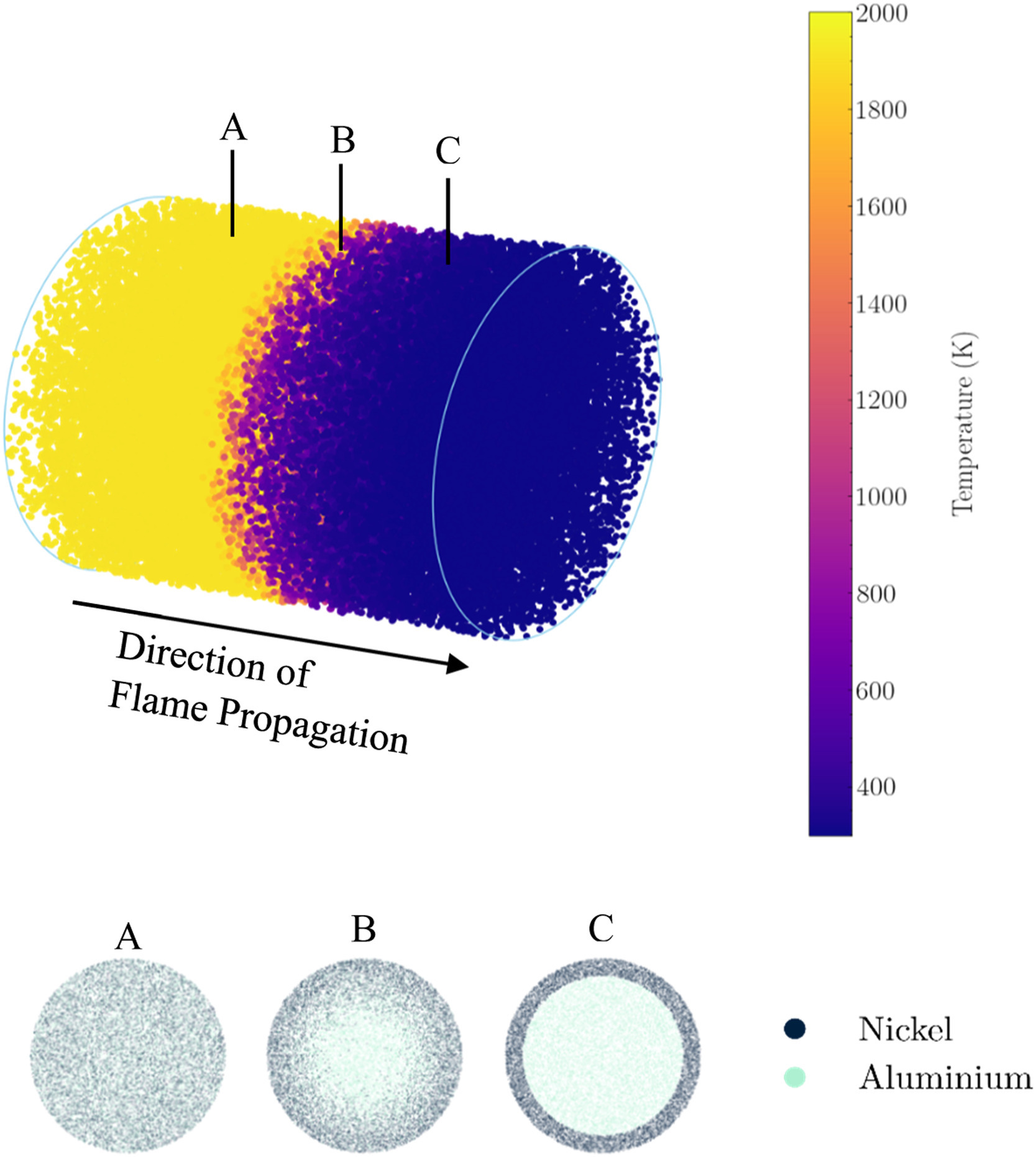
Molecular Simulations to Compute Thermodynamic and Transport Properties at Nano-scales
The goal of the project is to quantify various thermodynamic and transport properties at nano-scales using molecular scale simulations. Some of the properties that are being computed include melting and boiling points, latent heats of fusion and vaporization, surface tension, interfacial free energies.
Relevant Publications
Joshi et al., Comput. Mat. Sci 2018
Mathur et al., Chem. Phys. 2019

Novel Implicit Higher Order Shock-Capturing CFD Schemes
A higher-order implicit shock-capturing scheme is presented for the Euler equations based on time linearization of the implicit flux vector rather than the residual vector. The flux vector is linearized through a truncated Taylor-series expansion whose leading-order implicit term is an inner product of the flux Jacobian and the vector of differences between the current and previous time step values of conserved variables. The implicit conserved-variable difference vector is evaluated at cell faces by using the reconstructed states at the left and right sides of a cell face and projecting the difference between the left and right states onto the right eigenvectors. Flux linearization also facilitates the construction of implicit schemes with higher-order spatial accuracy (up to third order in the present study). To enhance the diagonal dominance of the coefficient matrix and thereby increase the implicitness of the scheme, wave strengths at cell faces are expressed as the inner product of the inverse of the right eigenvector matrix and the difference in the right and left reconstructed states at a cell face. The accuracy of the implicit algorithm at Courant–Friedrichs–Lewy (CFL) numbers greater than unity is demonstrated for a number of test cases comprising one-dimensional (1-D) Sod’s shock tube, quasi 1-D steady flow through a converging-diverging nozzle, and two-dimensional (2-D) supersonic flow over a compression corner and an expansion corner. The algorithm has the advantage that it does not entail spatial derivatives of flux Jacobian so that the implicit flux can be readily evaluated using Roe’s approximate Jacobian. As a result, this approach readily facilitates the construction of implicit schemes with high-order spatial accuracy such as Roe-MUSCL.
Relevant Publication
Mittakolu et al., Int. J. Num. Method. Heat Fluid Flow 2023
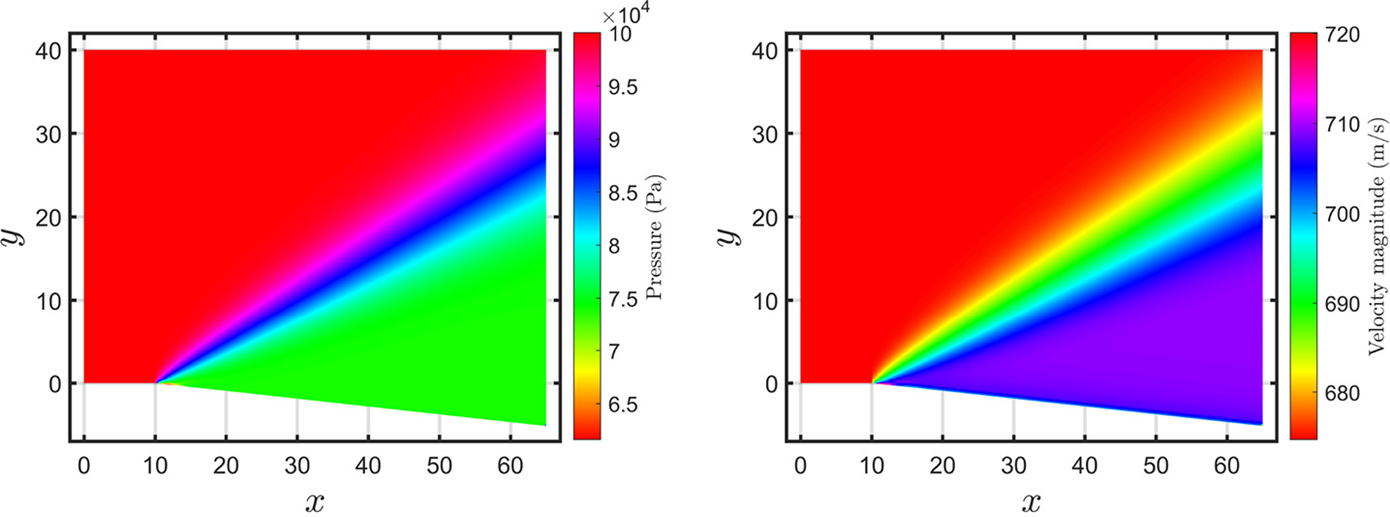
Experimental Investigation of Combustion of Reactive Pellets
A comprehensive experimental study of combustion of Ni/Al reactive pellets is studied. Burning rates are quantified as a function of particle size and packing density. The underlying physicochemical mechanisms are unraveled by exploring the relative importance of conductive and convective modes of flame propagation, powder morphology, pellet microstructure, temperature profiles, visual examination of burning process, and characterization of products.
